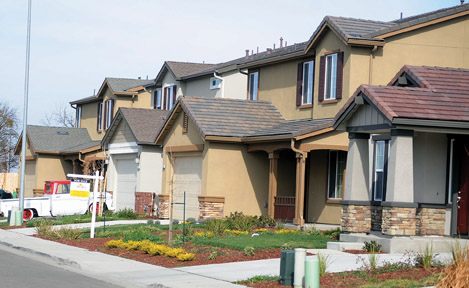Historically tepid state conditions reflected here
Historically tepid state conditions reflected here
Housing projects throughout San Benito County remain mostly in a holding pattern as developers wait for demand to pick up following a year in which housing starts hit record lows statewide.
“As far as new construction, it’s terrible,” said Damon Felice of Felice Consulting Services. The president of the Association of San Benito County Contractors said. “There’s nothing to work on right now, we’re kind of stagnant.”
The slow new-housing market locally echoes statewide trends, according to the California Building Industry Association, which last week said the state saw the third-lowest yearly housing permit total and worst yearly total on record for single-family units in 2011.
California homebuilders pulled permits for a record-low 21,420 single-family homes in 2011, down 16 percent from 2010. On the other hand, multi-family permits were up 33 percent from the previous year.
“We are far from being out of the woods just yet,” said Mike Winn, the building industry association’s president and chief executive officer. “Perhaps the only positive aspect to take away from this is that the numbers are at least headed in the right direction.”
In San Benito County, approved projects that are in the development pipeline include the 1,100-home Santana Ranch project on Fairview Road near Sunnyslope Road as well as Fairview Corners, which is slated for 220 units farther south on Fairview. Both have been approved, but there is no set timeline for dirt to be turned on construction there.
Santana Ranch developer Al Guerra said the project “is waiting for the market,” which appears to be the plan for many developers.
Gary Armstrong, the county’s director of planning and building inspection, added, “We’ve had a lot of people interested in looking at our county for potential projects, but not a lot is happening right now.”
County planning officials process about 30 permits per month, Armstrong said, including garage additions and remodeling projects. But permits for new residential construction in the county have trailed off from 65 total units in 2005 to just seven last year.
“We’re hopeful that we have some applications we think we’re going to get in, but they’d like to remain anonymous so far,” he said. “People have been requesting information and asking about things. There is a great deal of interest in the general plan that is being updated and may go to the Board of Supervisors this summer.”
The market and the economy will dictate when projects move forward, Armstrong said, sharing a sentiment with home-builders.
“We certainly entertain well planned-out projects that are felt to be good for the community at large and the economy and are in the right place with the right amenities that don’t detract from the things we’d like to preserve in the county,” he said.
Scott Fuller, general manager of San Juan Oaks, said that the golf course is not going to proceed just yet with planned residential development on the property as it works to increase the density of the housing within the same footprint that has already been approved.
“We feel this is a good time to get additional units approved,” he said. “That’ll take a year-and-a-half to two years. We’re not going to pull any building permits for the next couple of years. Instead, we’ll tweak our plan.”
That plan currently includes 156 single-family homes ranging from 4,500-square-foot lots to custom-sized lots on a half-acre. Most lots will be in the 6,000- to 7,000-square-foot size, Fuller said.
“We hope to have a denser project than we have now but all within the same footprint of our current approved project,” he said. “We’ll make it denser by adding more lots and adding smaller lots.”
Some of the planned lots are along the golf course and some are adjacent to open space, though none are planned in the hills above the course, Fuller said.
“In a couple years we’re hoping there will be greater demand and we’ll get started,” he added, noting that a 200-room hotel with “casitas” – or bungalows – is also approved and planned for construction once the housing projects begin. “We’re just hopeful that eventually the market will turn around.”
Felice said the slow local market has forced San Benito County contractors to seek work out of town.
“People are having to go farther and farther away,” he said. “It’s those indirect funds that impact our community. People are working out of town, getting gas out of town, eating out of town, even shopping out of town. That’s also hurting the city and county.”
Other than new housing built by Anderson Homes near Marguerite Maze School, most projects involving housing center on renovations, Felice said.
“It’s less expensive for people to purchase a foreclosed home, tear down everything but one wall, and go that way,” he said.
On the development side, Felice understands why projects are on hold.
“If I’m a developer right now, I’m trying to get everything approved, then I’d sit on it,” he said. “I wouldn’t build anything right now unless I had to.”
In the city of Hollister, 2011 “was not a great year for us either” housing-wise, said
William Avera, the development services director. Still, the number of housing units that went through final inspection did increase from the previous year.
“Anderson Home and K and B were the only ones that started homes other than what the RDA helped sponsor,” he said. “It was one of the slowest years since the building moratorium.”
In 2011, there were 166 total final inspections on new construction, including 104 multi-family units. That compares to 19 new single-family units that were inspected within the city limits in 2010.
The amount of foreclosures and homes available as short sales have saturated the market and made new home construction less appealing, Avera said.
“There are always people who want a brand new house, but those folks are fewer and farther between,” he said. “Interest rates are phenomenal, but it’s hard when new construction is competing with homes in which you can pick up the same square footage for 75 percent of what a brand new home is going to cost you.”
Larger developers, he added, “are still going to be the companies that build here. They can deal with that smaller profit margin. Smaller builders can’t afford to have product on the ground just sitting there.”
In the year ahead, Avera expects the Walnut Park subdivision to begin construction of 25 units off Union Road near Cerra Vista School. Its developers are still working with the engineering department to get a final map approved by the city council.









